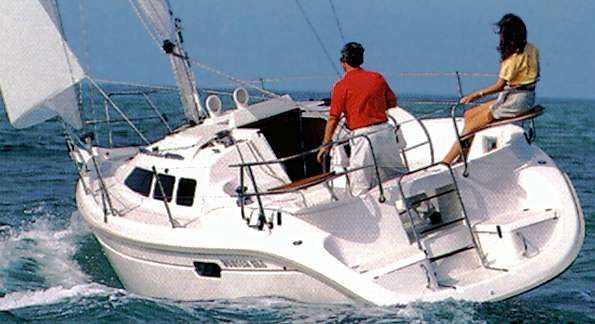Like most Hunter sailboats, the Hunter 29.5 offers maximum accommodations, a large comfortable cockpit, and reasonable sailing performance at an affordable price. The Hunter 29.5 was designed by Hunter’s in-house staff under Rob Mazza. It exemplifies a boat that appears to have been designed from the inside out rather than from the outside in.

Traditionally the approach to boat design is first to establish the shape of the hull and appendages and then fit the interior arrangement to accommodate the shape of the hull. However, as sales and marketing staffs have become increasingly influential in the design stages of production, it has become more common for boats to be designed from the inside out. Since comfort and cabin space are prime selling points, it makes perfect sense to consider the accommodations first and then design a hull and deck to fit around the interior.
Overall, I think the Hunter design team has done a good job of fitting the boat around the interior, although they have gone a little overboard on the windows. The Hunter 29.5 has five windows and ports along each side of the boat, and they are four different shapes, none of which are aesthetically very pleasing.
The overall length is 29’6", waterline length is 25’3", beam is a very wide 10’6", and draft is a modest 4-feet with a shoal draft wing keel.
Like all production boats in this size range, the Hunter 29.5 is constructed from fiberglass composites utilizing a modular type of construction. The hull, deck, structural grid, and interior components are molded separately and then assembled into the finished product with structural adhesives or secondary bonds of fiberglass and resin. The deck is cored with balsa wood, and the hull is a solid composite.
The first year of production of the 29.5 was 1994. Since the oldest of these models are less than 10 years old, there has been insufficient time to judge whether there are consistent problems with the 29.5, but I would expect that in time, leaks around windows and ports will become a persistent problem.
The 29.5 has a rather large cockpit for her size that opens at the stern to a molded swim platform. At anchor, this becomes an integral part of the cockpit adding even more useable space. This is one of the 29.5’s more appealing features, and it makes getting in and out of the water or dinghy quite easy.
Wheel steering is standard with the helm at the aft end of the cockpit, and there are two seats incorporated into the stern rail for passenger seating. Although these seats keep inexperienced crew members clear of the action, this places too much weight at the extreme end of the boat where it is least desirable. Because the side decks are narrow with rigging shrouds at the deck edge, to go forward, the best path is over the cabin trunk. The foredeck has a small anchor locker which will accommodate a 13 pound Danforth with chain leader and 100-feet of half-inch rode. There are also two sturdy anchor rollers forward.
Below deck, the cabin is wide open with the only privacy offered by a fully enclosed head. There is a V-berth forward, and the main saloon features a large U-shaped dinette which comfortably seats four adults. The head and a small hanging locker are to starboard, and the galley is to port with a two-burner non-pressurized alcohol stove, ice box and single sink. Aft and below the cockpit is an athwartships double berth. The most notable disadvantage of the 29.5’s open arrangement is that there is minimal storage space. The athwartships double berth eliminates cockpit seat lockers; storage beneath the galley stove and sink is limited; and what storage there is below the dinette seats and V-berth is difficult to access.
Auxiliary power is provided by a two-cylinder, 18 hp Yanmar diesel contained in an engine box beneath the companionway steps. This workhorse of an engine dominates the market in boats of this size and is very dependable. Quick access for maintenance is limited but, if necessary, the engine box can be removed easily for more serious work.
The 29.5 is designed with simplicity in mind, and the large mainsail and small fractional jib certainly make tacking and sail handling a breeze for the short-handed or single-handed sailor. Without a traveler, the mainsheet attaches to the steering console directly in front of the helmsman. Sheet winches are also within easy reach of the helm. The B&R rig features long spreaders that are swept back 30 degrees eliminating a backstay. This necessitates tacking downwind to avoid impaling the mainsail on the spreaders, but I think that most would not find this much of an inconvenience. With the proper tacking angles, this can actually be a faster way to sail downwind.
Reviewed in the July 2002 issue of SpinSheet by Jack Hornor




